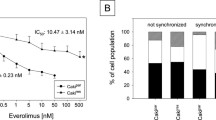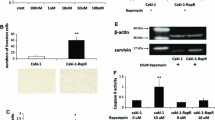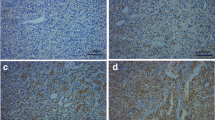Abstract
Background
It has not been well documented that the modulation of stress response mediates the efficacy of the mammalian target of rapamycin (mTOR) inhibitor in renal cell carcinoma (RCC).
Objective
The objective of this study was to investigate whether the activity of the mTOR inhibitor temsirolimus against RCC could be enhanced by OGX-011, an antisense oligodeoxynucleotide (ODN) targeting the stress-activated chaperone clusterin.
Methods
We investigated the efficacy of combined treatment with temsirolimus plus OGX-011 in a human RCC Caki-1 model focusing on the effects on apoptotic and autophagic pathways.
Results
Although clusterin expression was increased by temsirolims, additional treatment of Caki-1 with OGX-011 significantly inhibited clusterin upregulation (p < 0.05). Combined treatment of temsirolimus and OGX-011 synergistically enhanced the sensitivity of Caki-1 to temsirolimus (p < 0.01), reducing the IC50 by approximately 50 %. Apoptotic changes were marked in Caki-1 following combined treatment with a sublethal dose of temsirolimus and OGX-011, accompanying the significant downregulation of Mcl-1 (p < 0.05), but not with either agent alone. Furthermore, this combined treatment markedly blocked the temsirolimus-induced activation of autophagy in Caki-1 (p < 0.01). In-vivo systemic administration of temsirolimus plus OGX-011 significantly inhibited the growth of Caki-1 tumors compared with that of temsirolimus plus control ODN (p < 0.05).
Conclusions
Silencing of clusterin using OGX-011 resulted in the further enhancement of proapoptotic activity as well as the marked attenuation of the autophagic pathway induced by temsirolimus in a human RCC model. Thus, the combined use of OGX-011 could be a promising strategy through the enhanced cytotoxic activity of temsirolimus against RCC.






Similar content being viewed by others
References
Figlin R, Sternberg C, Wood CG. Novel agents and approaches for advanced renal cell carcinoma. J Urol. 2012;188:707–15.
Bellmunt J, Montagut C, Albiol S, Carles J, Maroto P, Orsola A. Present strategies in the treatment of metastatic renal cell carcinoma: an update on molecular targeting agents. BJU Int. 2007;99:274–80.
Fasolo A, Sessa C. Targeting mTOR pathways in human malignancies. Curr Pharm Des. 2012;18:2766–77.
Shor B, Zhang WG, Toral-Barza L, Lucas J, Abraham RT, Gibbons JJ, et al. A new pharmacologic action of CCI-779 involves FKBP12-independent inhibition of mTOR kinase activity and profound repression of global protein synthesis. Cancer Res. 2008;68:2934–43.
Hudes G, Carducci M, Tomczak P, Dutcher J, Figlin R, Kapoor A, et al. Temsirolimus, interferon alfa, or both for advanced renal-cell carcinoma. N Engl J Med. 2007;356:2271–81.
Voss MH, Molina AM, Motzer RJ. mTOR inhibitors in advanced renal cell carcinoma. Hematol Oncol Clin North Am. 2011;25:835–52.
Miyake H, Harada K, Kumano M, Fujisawa M. Assessment of efficacy, safety and quality of life of 55 patients with metastatic renal cell carcinoma treated with temsirolimus: a single-center experience in Japan. Int J Clin Oncol. 2014;19:679–85.
Shannan B, Seifert M, Leskov K, Willis J, Boothman D, Tilgen W, et al. Challenge and promise: roles for clusterin in pathogenesis, progression and therapy of cancer. Cell Death Differ. 2006;13:12–9.
Zoubeidi A, Gleave M. Small heat shock proteins in cancer therapy and prognosis. Int J Biochem Cell Biol. 2012;44:1646–56.
Miyake H, Muramaki M, Kurahashi T, Yamanaka K, Hara I, Gleave M, et al. Expression of clusterin in prostate cancer correlates with Gleason score but not with prognosis in patients undergoing radical prostatectomy without neoadjuvant hormonal therapy. Urology. 2006;68:609–14.
Miyake H, Gleave M, Kamidono S, Hara I. Overexpression of clusterin in transitional cell carcinoma of the bladder is related to disease progression and recurrence. Urology. 2002;59:150–4.
Zoubeidi A, Chi K, Gleave M. Targeting the cytoprotective chaperone, clusterin, for treatment of advanced cancer. Clin Cancer Res. 2010;16:1088–93.
Miyake H, Yamanaka K, Muramaki M, Hara I, Gleave ME. Therapeutic efficacy of adenoviral-mediated p53 gene transfer is synergistically enhanced by combined use of antisense oligodeoxynucleotide targeting clusterin gene in a human bladder cancer model. Neoplasia. 2005;7:171–9.
Miyake H, Nelson C, Rennie PS, Gleave ME. Testosterone-repressed prostate message-2 is an antiapoptotic gene involved in progression to androgen independence in prostate cancer. Cancer Res. 2000;60:170–6.
Kurahashi T, Muramaki M, Yamanaka K, Hara I, Miyake H. Expression of the secreted form of clusterin protein in renal cell carcinoma as a predictor of disease extension. BJU Int. 2005;96:895–9.
Miyake H, Hara S, Arakawa S, Kamidono S, Hara I. Over expression of clusterin is an independent prognostic factor for nonpapillary renal cell carcinoma. J Urol. 2002;167:703–6.
Zellweger T, Miyake H, July LV, Akbari M, Kiyama S, Gleave ME. Chemosensitization of human renal cell cancer using antisense oligonucleotides targeting the antiapoptotic gene clusterin. Neoplasia. 2001;3:360–7.
Kususda Y, Miyake H, Gleave ME, Fujisawa M. Clusterin inhibition using OGX-011 synergistically enhances antitumour activity of sorafenib in a human renal cell carcinoma model. Br J Cancer. 2012;106:1945–52.
Al-Asaaed S, Winquist E. Custirsen (OGX-011): clusterin inhibitor in metastatic prostate cancer. Curr Oncol Rep. 2013;15:113–8.
Terakawa T, Miyake H, Kusuda Y, Fujisawa M. Expression level of vascular endothelial growth factor receptor-2 in radical nephrectomy specimens as a prognostic predictor in patients with metastatic renal cell carcinoma treated with sunitinib. Urol Oncol. 2013;31:493–8.
Wei Y, Zou Z, Becker N, Anderson M, Sumpter R, Xiao G, et al. EGFR-mediated Beclin 1 phosphorylation in autophagy suppression, tumor progression, and tumor chemoresistance. Cell. 2013;154:1269–84.
Ladoire S, Chaba K, Martins I, Sukkurwala AQ, Adjemian S, Michaud M, et al. Immunohistochemical detection of cytoplasmic LC3 puncta in human cancer specimens. Autophagy. 2012;8:1175–84.
Roulin D, Waselle L, Dormond-Meuwly A, Dufour M, Demartines N, Dormond O. Targeting renal cell carcinoma with NVP-BEZ235, a dual PI3K/mTOR inhibitor, in combination with sorafenib. Mol Cancer. 2011;10:90.
Rindi G, Klöppel G, Alhman H, Caplin M, Couvelard A, de Herder WW, et al. TNM staging of foregut (neuro) endocrine tumors: a consensus proposal including a grading system. Virchows Arch. 2006;449:395–401.
Janku F, McConkey DJ, Hong DS, Kurzrock R. Autophagy as a target for anticancer therapy. Nat Rev Clin Oncol. 2011;8:528–39.
Jung CH, Ro SH, Cao J, Otto NM, Kim DH. mTOR regulation of autophagy. FEBS Lett. 2010;584:1287–95.
Komatsu M, Ichimura Y. Physiological significance of selective degradation of p62 by autophagy. FEBS Lett. 2010;584:1374–8.
Zoubeidi A, Ettinger S, Beraldi E, Hadaschik B, Zardan A, Klomp LW, et al. Clusterin facilitates COMMD1 and I-kB degradation to enhance NF-kB activity in prostate cancer cells. Mol Cancer Res. 2010;8:119–30.
Zhang H, Kim JK, Edwards CA, Xu Z, Taichman R, Wang CY. Clusterin inhibits apoptosis by interacting with activated Bax. Nat Cell Biol. 2005;7:909–15.
Lamoureux F, Thomas C, Yin MJ, Kuruma H, Beraldi E, Fazli L, et al. Clusterin inhibition using OGX-011 synergistically enhances Hsp90 inhibitor activity by suppressing the heat shock response in castrate-resistant prostate cancer. Cancer Res. 2011;71:5838–49.
Liu H, Yang J, Yuan Y, Xia Z, Chen M, Xie L, et al. Regulation of Mcl-1 by constitutive activation of NF-kB contributes to cell viability in human esophageal squamous cell carcinoma cells. BMC Cancer. 2014;14:98.
Yang ZJ, Chee CE, Huang S, Sinicrope FA. The role of autophagy in cancer: therapeutic implications. Mol Cancer Ther. 2011;10:1533–41.
Jung CH, Jun CB, Ro SH, Kim YM, Otto NM, Cao J, et al. ULK-Atg13-FIP200 complexes mediate mTOR signaling to the autophagy machinery. Mol Biol Cell. 2009;20:1992–2003.
Mizushima N. The role of the Atg1/ULK1 complex in autophagy regulation. Curr Opin Cell Biol. 2010;22:132–9.
Caccamo A, Majumder S, Richardson A, Strong R, Oddo S. Molecular interplay between mammalian target of rapamycin (mTOR), amyloid-beta, and Tau: effects on cognitive impairments. J Biol Chem. 2010;285:13107–20.
Hsueh YS, Chang HH, Chiang NJ, Yen CC, Li CF, Chen LT. MTOR inhibition enhances NVP-AUY922-induced autophagy-mediated KIT degradation and cytotoxicity in imatinib-resistant gastrointestinal stromal tumors. Oncotarget. 2014;5:11723–36.
Mathew R, Karantza-Wadsworth V, White E. Role of autophagy in cancer. Nat Rev Cancer. 2007;12:961–7.
Chi KN, Eisenhauer E, Fazli L, Jones EC, Goldenberg SL, Powers J, et al. A phase I pharmacokinetic and pharmacodynamic study of OGX-011, a 20-methoxyethyl antisense oligonucleotide to clusterin, in patients with localized prostate cancer. J Natl Cancer Inst. 2005;97:1287–96.
Jackson JK, Gleave ME, Gleave J, Burt HM. The inhibition of angiogenesis by antisense oligonucleotides to clusterin. Angiogenesis. 2005;8:229–38.
Author information
Authors and Affiliations
Corresponding author
Ethics declarations
Funding
None.
Conflict of Interest
The University of British Columbia has submitted patent applications, listing Hideaki Miyake and Martin Gleave as inventors, on the sequence of OGX-011. This intellectual property has been licensed to OncoGenex Technologies, in which Martin Gleave has founding shares. Masatomo Nishikawa and Masato Fujisawa declare no conflict of interest.
Electronic supplementary material
Below is the link to the electronic supplementary material.
ESM 1
(PPTX 40 kb)
Rights and permissions
About this article
Cite this article
Nishikawa, M., Miyake, H., Gleave, M. et al. Effect of Targeting Clusterin Using OGX-011 on Antitumor Activity of Temsirolimus in a Human Renal Cell Carcinoma Model. Targ Oncol 12, 69–79 (2017). https://doi.org/10.1007/s11523-016-0448-3
Published:
Issue Date:
DOI: https://doi.org/10.1007/s11523-016-0448-3




